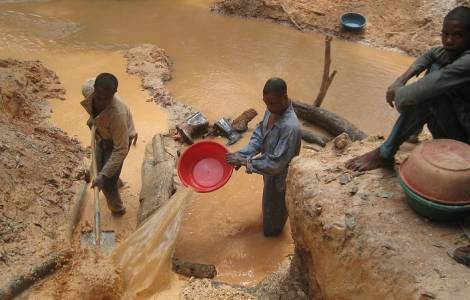Africa / d. CONGO – The “3Ts” are an example of the exploitation of Congolese resources

Africa / d. CONGO – The “3Ts” are an example of the exploitation of Congolese resources
Kinshasa (Agenzia Fides) – “3T” – tin (tin or tin), wolframite (tungsten), coltan (tantalum) – are the main resources plundered in eastern DRC, according to documents of various organizations in the DRC. The United Nations, which for years has been preparing reports on this subject.
Pope Francis reiterated, yesterday, January 31, in the garden of the Palace of the Nation in Kinshasa, during his meeting with the Congolese authorities, civil society and the diplomatic corps: “Africa is not a mine to be exploited or a land to be plundered”. (See Fides 1/31/2023). The Congo from the beginning of colonization, as a private initiative of a European Catholic ruler, the King of Belgium, was always viewed in this light. The exploitation that also affected its inhabitants was also denounced by the historians of the time, among them the American writer Mark Twain.
Exploitation continues today but in a more sophisticated and diversified way. As the Congolese human rights activist Pierre Cabeza said (see Fides 1/26/2023), the exploitation of Congolese resources “can be represented as a tree whose roots represent the great powers of the world, along with their multinational corporations. The trunk of the tree is the neighboring countries of the Democratic Republic of the Congo (DRC) Rwanda and Uganda) that receive assistance from the superpowers and, finally, the offshoots are the various guerrilla groups operating in the Congolese territory. The sap that feeds the tree is economic interests.”
In fact, there are more than 100 groups fighting for control of the three eastern Congolese provinces (North Kivu, South Kivu, and Ituri). They are also those who commit crimes against the civilian population for illegally exploiting natural resources. In addition to the “3Ts” there is gold, diamonds, cobalt and copper, but there is also wildlife, coal and timber, as well as hashish. Goods which are then transported to Rwanda, Burundi and Uganda and from these countries to international markets.
The course of military operations of the various rebel groups (but also of the Congolese army, whose units are no strangers to illegal trade) reflects the map of the region’s resources. As the latest report sent to Agenzia Fides by the Network for Peace in the Congo points out, among the objectives of the revived Movement of March 23 (M23) is “to preserve the ‘Little North’ in North Kivu, namely the city of Goma and the lands of Nyiragongo, Ruturu, Masisi and Walikale, rich in minerals (gold and coltan tin and cobalt) under the economic, military and political influence of the Rwandan regime.”
For this reason, in recent weeks the M23 has occupied more than 100 villages in Rutshuru territory; In many of them, he established an administration parallel to the state administration, appointing new local authorities loyal to him, and imposing illegal taxes.
Finally, people are also being exploited. It is the miners, often between the ages of 14 and 25, who do high-risk work in dangerous places, in harsh conditions, risking their lives from landslides and diseases that could have been avoided if they had minimal forms of protection.
(LM) (Agenzia Fides 1/2/2023)
Share:

“Coffee fanatic. Gamer. Award-winning zombie lover. Student. Hardcore internet advocate. Twitter guru. Subtly charming bacon nerd. Thinker.”











